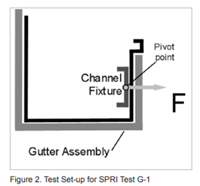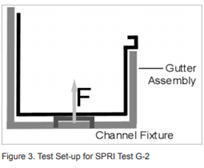The roof is an integral part of the building envelope, and edge metal is the first line of defense to ensure your membrane is secure and sealed, protecting against blowoffs and water damage. To provide reassurance and peace of mind, the International Code Council updated International Building Code (IBC) to incorporate testing requirements that ensure this critical component is ready to battle the elements. This article will guide you through the new ANSI/SPRI GT-1 testing standard that is part of the 2021 and 2024 IBC.
What is ANSI/SPRI GT-1?
After two years of development led by SPRI, the Single Ply Roofing Industry group, ANSI/SPRI GT-1 became an official ANSI standard in May 2016. Like ANSI/SPRI/ FM 4435/ES-1 is to fascia and coping, ANSI/SPRI GT-1 provides a standard test method for gutter systems that secure membrane on commercial low slope roof systems for load resistance. In December of 2019, the International Building Code approved the inclusion of ANSI/SPRI GT-1 into the 2021 cycle.
Who are the key players?
The American National Standards Institute (ANSI) is a private, not-for-profit organization that supports the U.S. voluntary standards and conformity assessment system. Encompassing practically every industry, the Institute represents the diverse interests of more than 270,000 companies and 30 million professionals worldwide.
Single Ply Roofing Industry (SPRI) is a national single-ply roofing association comprised of manufacturers and professionals. SPRI is a technical and statistical authority for the single-ply roofing industry and represents the industry’s sheet membrane and suppliers.
Factory Mutual (FM) is a conglomeration of insurance companies. To limit their exposure to loss, FM has developed testing standards for materials used on the properties they insure. All FM Approved products are listed on the RoofNav database.
The American Society of Civil Engineers (ASCE) is the most respected engineering society in the US and represents civil engineers around the world. ASCE maintains the Minimum Design Loads and Associated Criteria for Buildings and Other Structures (ASCE 7), that is a vital part of many building codes.
How did we get here?
SPRI published “Wind Design Guide for Edge Systems Used with Low Slope Roofing Systems,” their first guide, in 1994. Four years later, the first edition of ANSI/SPRI ES-1 was created, having been derived from the original SPRI version. In 2003, ANSI/SPRI ES-1 was introduced into International Building Code. Gutters were not included until 2010, when ANSI/SPRI GD-1 was established. The following year, FM Global updated their edge metal testing standard, FM 4435, to match the ES-1 method, now known as ANSI/SPRI/FM 4435/ES-1.
ANSI/SPRI GT-1 became an ANSI standard on May 26, 2016, after roughly two years in development. GT-1 further separated the design and testing standards for edge systems:
- Design: Fascia, Coping, Gutters (ANSI/SPRI ED-1)
- Testing: Fascia, Coping (ANSI/SPRI/FM 4435/ES-1)
- Testing: Gutters (ANSI/SPRI GT-1)
ANSI/SPRI GT-1 was subsequently adopted into the IBC in 2021.
Why have a testing standard?
ANSI/SPRI GT-1 provides a consensus for an expectable level of performance with real world practicality. When design professionals, fabricators, and installers are looking for testing information on wind load resistance and roof edge securement, ANSI/SPRI GT-1 has the answers. Overall, the main goal of having ANSI/SPRI GT-1 is to protect owners, occupants, architects, and installers by providing a universal guide for consistent performance.
When will GT-1 apply in my area?
Over 30 states, counties, and cities have already adopted 2021 IBC, and additional adoptees are slated to follow soon. ANSI/SPRI GT-1 is vital for contractors and architects, who should get ahead of the new changes before their area adopts the updated building code. Click here to see what version of IBC your state currently follows.
Where is it referenced in IBC?
GT-1 is found in Chapter 15, just like ES-1, and can be downloaded here.
Section 1504.6.1 GUTTER SECUREMENT FOR LOW SLOPE ROOFS
“Gutter that are used to secure the perimeter edge of the roof membrane on low-slope (less than 2:12) built-up, modified bitumen, and single ply roofs, shall de designed, constructed, and installed to resist wind loads in accordance with section 1609 and shall be tested in accordance with Test Methods G-1 and G-2 pf SPRI GT-1.
How do the GT-1 tests work?
There are two tests conducted: G-1 (Horizontal Test Pressure) and G-2 (Vertical Test Pressure). There is a third test, G-3, that measures the resistance of the gutter system to test forces acting downward such as water, ice, and snow loads. Even though G-3 is part of GT-1 testing, only G-1 and G-2 are directly cited in the 2021 IBC.
 Test G-1: Horizontal Test Pressure measures the resistance of the gutter system to test forces acting outwardly (away from the building). The highest load held without failure is used to calculate the pressure by dividing the total force by the area of the gutter face.
Test G-1: Horizontal Test Pressure measures the resistance of the gutter system to test forces acting outwardly (away from the building). The highest load held without failure is used to calculate the pressure by dividing the total force by the area of the gutter face.
Pressure = Load / (Face Height x Length)
 Test G-2: Vertical Test Pressure measures the resistance of the gutter system to test forces acting upwardly tending to lift the gutter off the building. The highest load held without failure is used to calculate the pressure by dividing the total load by the total width of the gutter.
Test G-2: Vertical Test Pressure measures the resistance of the gutter system to test forces acting upwardly tending to lift the gutter off the building. The highest load held without failure is used to calculate the pressure by dividing the total load by the total width of the gutter.
Pressure = Load / (Gutter Width x Length)
What's at stake?

In 2016, Hurricane Matthew devastated many portions of Florida. In just one example, a 7,000 sq. ft. large box retailer saw substantial damage from 80-90 MPH winds. The cause of the damage was most likely from a loose gutter and/or flashing, which led to the roof covering peeling back.
The situation was design preventable, and proper gutter/flashing securement would have resulted in no loss. Instead, the retail store was hit with a $70,000 repair cost claim, $1.7 million content cost claim, and $1.75 million business interruption claim for a grand total of $3.52 million. (Source: AIG RICOWI Presentation Slides March 2019)
How can we help?
Our team is ready to help you understand the new GT-1 Standards and update your low slope membrane gutter specification.
Our Wind Resistant Gutter and Wind Resistant Xl Gutter are ANSI/SPRI GT-1 approved and backed by a 30-Year, 160 MPH Wind Warranty.
Searching for more information on GT-1 or have a specific question we didn’t cover? Click here to find your local rep who can assist you with any inquiries.